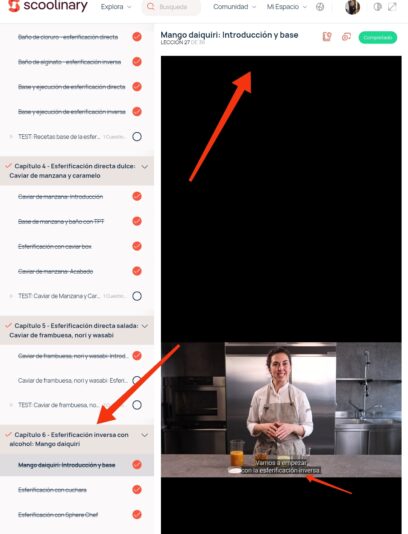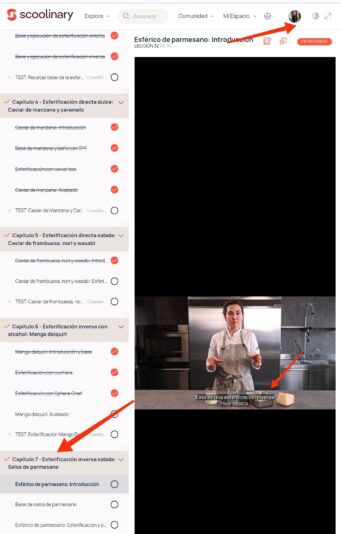Forum Replies Created
-
Level:
Scoolinary Team
Hola Milo.
Entre desde tu cuenta y pude visualizar el capítulo 6 y 7 que son sobre esferificacion inversa (adjunto imágenes).
Te pediría por favor que me indiques si lo estás viendo desde la App o desde la web de Scoolinary. Y también te pediría que tomes una captura de pantalla del mensaje en la pantalla que te indica que no se puede reproducir el video.
Me quedo atenta a tu respuesta.
Saludos.
-
Level:
Scoolinary Team
Hola Milo.
En el vídeo y recetario se indica 16 mm ( milímetros) pero revisando el chef indica que está usando la masa clásica de Croissant la cual tienen una medida de 50×30 centímetros ,luego de hacer los pliegues y vueltas la masa queda en un rectángulo que aproximadamente mide 16 x 10 centímetros.
Cómo no estoy segura si el chef hace referencia al largo de la masa o al grosor de la masa lo voy a consultar con el equipo de contenidos para su revisión y en cuanto tenga una respuesta vuelvo a tí.
Saludos.
-
Level:
Scoolinary Team
Hola Milton, ¡gracias por tu pregunta! Esto que planteas es súper común cuando uno empieza a trabajar con masa madre en recetas más complejas como panes enriquecidos.
Respondo tus preguntas:
1. Sí, cuando usás masa madre, hay que restar la harina y el agua que lleva esa masa madre del total de la receta. Eso te ayuda a mantener la proporción justa de hidratación y que la masa se comporte como esperás.
2. Para calcularlo, primero tienes que ver cuánto estás usando de masa madre. Si dices que usás un 20%, y tu masa madre está alimentada 1:1:1 (es decir, partes iguales de MM, agua y harina), entonces de esos 200 g (si tu receta tiene 1000 g de harina), 100 g son harina y 100 g son agua. Y esos 100 g de cada uno se descuentan de la receta base.
Si alimentas a 1:2:2, cambia un poco la cuenta, pero la idea es la misma: tienes que saber cuánta harina y agua contiene la MM que vas a usar, y restarlo del total.
3. Que estés alimentando tu MM con distintos ratios está perfecto. Lo importante es que, cuando la vas a usar, sepas qué proporción tiene para poder ajustar tu fórmula.
Espero que esto te aclare el panorama. Con un par de cálculos ya lo vas a tener dominado.
¡Saludos!
-
Sussan Estela Olaya
AdministratorMay 8, 2025 at 20:20 in reply to: Croissant dough is tough and dimmpled.Level:Scoolinary Team
Hi Megan, thanks for sharing what you’re going through.
You’re definitely not alone,most of us have ended up with croissant dough that feels more like Play-Doh at some point!
From what you describe (tough, uneven, and dimpled), a few things could be going on. The T45 flour the chef mentions is fine, as long as it has 12–13% protein and a PL value between 0.4 and 0.7 (that just tells you how elastic and extensible the dough will be).
Sometimes even if the protein is right, if the PL is off, the dough won’t behave as expected.
How you’re mixing also makes a big difference,did you knead it by hand or use a professional mixer? That can really affect the outcome.
When kneading by hand, overworking the dough without breaks can cause the gluten to get too tight. And with a machine, if the dough gets too warm or overmixed, it can become rubbery and tough.
And one really important thing: this kind of dough is hard. If it’s your first time, don’t get discouraged.
Making good croissants takes practice and lots of trial and error before you really get the feel for the lamination, the mixing, the chilling, the baking,everything! You’re already on the right track just by trying and asking for help.
Hope this helps!
All the best!
-
Level:
Scoolinary Team
Hi Xhesika.
The recipe using the Kent mix cannot be substituted, as it’s a bonus (extra) recipe from the course. The Kent mix is a factory-made preparation that comes ready to use.
In any case, you have the Baked Cheesecake course, where in Chapter 2 you’ll see how to make a traditional cheesecake, which is very similar to the result you get using the Kent mix.
https://www.scoolinary.com/courses/baked-cheesecakes
You also have access to the cheesecake recipe from the Essential Cakes course, Chapter 3 – Cheesecake.
https://www.scoolinary.com/courses/essential-cakes
Best regards!.
scoolinary.com
Baked Cheesecakes: Learn infallible recipes and techniques
Learn to prepare 6 versions of baked cheesecakes with creamy textures and unique flavors. Discover techniques and secrets to achieve irresistible desserts.
-
Sussan Estela Olaya
AdministratorMay 8, 2025 at 15:18 in reply to: Curso de panadería con masa madreLevel:Scoolinary Team
Genial Rosa, ya nos cuentas si haciendo cambios logras que tú brioche salga más ligerito o más esponjoso. Aquí estoy por si te surge alguna otra consulta y con gusto te ayudo a resolverlo.
Saludos.
-
Sussan Estela Olaya
AdministratorMay 8, 2025 at 03:32 in reply to: Con o SIN Ventilación los MacaronsLevel:Scoolinary Team
Hola Cinthya.
Te comento; en los macarons, el uso de ventilación (aire forzado) o no durante la cocción puede variar según la receta y los ingredientes.
En macarons dulces tradicionales, muchas recetas recomiendan sin ventilación para evitar que se formen grietas o que se seque demasiado rápido la superficie, ya que eso puede afectar el desarrollo del pie (la base característica del macaron).
En otros casos (como en macarons salados o con ciertas composiciones de azúcar o harina de frutos secos), sí se puede utilizar ventilación, porque ayuda a obtener una costra más uniforme o controlar mejor la humedad residual en función del horno y del tipo de relleno que se usará después.
Te pediría por favor, me indiques en cuál receta en concreto viste que el recetario dice sin ventilación y en el video dice con ventilación. Así puedo revisar ese material puntual y, si es necesario, enviar la observación al equipo de contenidos para aclararlo o ajustarlo.
¡Gracias de antemano por tu ayuda y por estar tan atenta a los detalles!.
Saludos.
-
Level:
Scoolinary Team
Hola Jorgelina.
La masa de Croissant ( primera edición) se estira de 38 centímetros de ancho por 72 centímetros de largo. Luego se marcan 8 rectángulos y luego se divide cada rectángulo en dos triángulos y así se van formando los croissant’s.De una receta completa salen 16 unidades de croissant.
Espero que esta información sea de ayuda.
Saludos.
-
Level:
Scoolinary Team
Hola Jorgelina.
Antonio Bachour (como muchos pasteleros y panaderos profesionales) suele agregar la levadura fresca en cubos o desmigajada directamente en la masa sin diluir por varias razones:
▪️ La levadura fresca se incorpora perfectamente durante el amasado. Como este brioche lleva un amasado prolongado (20 minutos en total a baja velocidad), la levadura se deshace y se reparte de manera homogénea sin problemas.
▪️ No es necesario diluirla si la hidratación de la masa es suficiente. En este caso, hay huevos, leche, yemas y azúcar invertido, así que el medio es suficientemente húmedo para que la levadura se disuelva sin dificultad.
▪️ Control de fermentación: a veces, disolver la levadura en líquido antes puede acelerar su activación antes de tiempo. Mezclándola directamente, se asegura una distribución controlada y uniforme en la masa mientras se amasa.Así que sí , aunque no se diluya previamente, se disuelve perfectamente en la masa durante el amasado largo, sobre todo con masas enriquecidas como este brioche. De hecho, esta es una práctica común en bollería de alto nivel.
Espero que esta información sea de ayuda.
Saludos.
-
Level:
Scoolinary Team
-
Level:
Scoolinary Team
Hi,Welcome to the Scoolinary community!
On our platform, we have two macaron courses. One of them is Sweet and Savory Macarons with Chef Elena Adell, featuring 11 macaron recipes ranging from the classics to the most innovative creations.
Chef Elena teaches the base macaron technique, which you can adapt to create a wide variety of flavors and textures.
We also offer the Macaron course by Chef Damien Wager, where by the end of this online course, you’ll be able to:
Learn how to make macaron shells using French, Italian, and vegan meringue techniques, and produce a variety of macaron fillings.
Know how to store and preserve your macarons so you can enjoy them in perfect condition.
Both courses are packed with techniques and valuable knowledge.
If you have any other questions, I’ll be happy to help.
Best regards!
-
Sussan Estela Olaya
AdministratorMay 7, 2025 at 20:53 in reply to: Instructions and Ingredients for Kabocha Squash Puree – Tasting Menu DesignLevel:Scoolinary Team
Hi Louis.
Thank you for your message. I’ve reviewed the course and I’m forwarding your feedback to the content team. I’ll get back to you as soon as I have a response.
Best regards.
-
Level:
Scoolinary Team
Hi Christofer.
Yes, it’s normal for pistachios to feel a bit gummy or soft after blanching and peeling them, because they absorb water during boiling. However, before roasting, they need to be properly dried. If they’re still moist, they won’t roast evenly, they might release steam into the caramel, and they’ll lose both color and texture.
How to dry them properly
Quick oven-drying: Spread the peeled pistachios on a tray and bake at 120°C (250°F) for 10–15 minutes, stirring halfway through.Just until they feel dry to the touch , don’t toast them, you’re not looking for color at this stage.
Air-drying: If you’re not in a hurry, lay them out on absorbent paper or a clean kitchen towel and let them air dry for 2–4 hours at room temperature.
Once dry, you can roast them at 140–150°C (285–300°F) for 8–12 minutes to enhance their aroma without losing their vibrant green color.Tip:If you have a dehydrator, it’s an excellent option to dry them thoroughly without any risk of toasting.
Best regards!.
-
Level:
Scoolinary Team
Exactly!
Let me break it down clearly for you so you have a proper, aromatic pistachio praliné process:
Green Pistachio Praliné:
1. Blanch the pistachios:Boil them for 1 minute, then chill in ice water. Peel and dry them thoroughly.
2. Toast the pistachios:Bake at 140–150 ºC (285–300 ºF) for 8–12 minutes. Just until they dry out and release their aroma — without browning.
3. Make the caramel:Cook the sugar to 160–165 ºC (320–330 ºF), a light blond caramel.
4. Combine:Pour the caramel over the pistachios. Let it cool down, then blend into a paste.
Extra tip:If you want to boost the green color, you can add a spoonful of 100% pistachio paste or a few drops of pistachio oil at the end.
That way, you’ll have a beautifully green praliné, with a delicate flavor and no brown tones.
Hope this is helpful, Best regards!
-
Level:
Scoolinary Team
Hola Carmen.
Para activar las notificaciones de mensajes es dentro del mensaje que posteas.En la parte inferior izquierda verás una casilla para marcar.
La marcas y se te notificará cada vez que alguien conteste tu post(adjunto imagen). Creo que sí intentas editar tu post debería salirte la opción. Nos cuentas si la puedes visualizar.
Saludos.








